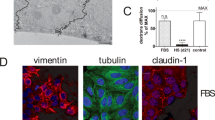Abstract
The histopathological response and cell culture characteristics of liver cells from the R16 (grc −) strain of rats, which carries an MHC-linked deletion, were examined one week after a single intraperitoneal injection of 200 mg/ kg body weight diethylnitrosamine (DEN) and were compared with the response of liver cells from wild type (grc+) rats. The DEN exposure induced hydropicl vacuolar changes in the parenchymal cells and a limited proliferation of oval cells in the periportal areas of the livers of both grc+ and grc rats. Primary culture of collagenase-digested livers consisted of parenchymal, bile ductular and oval-related cells as determined by cell-specific immunohistochemistry. Subpassaged cells from grc+ rats exhibited oval cell ultrastructural morphology, inducible histochemical staining for gammaglutamyl transpeptidase (GGT), and DEN-associated onset of anchorage-independent growth. Primary cultures of liver cells from R16 rats consistently failed to form cell strains upon subpassage.
Similar content being viewed by others
Abbreviations
- DEN:
-
diethylnitrosamine
- grc :
-
growth and reproduction complex
- GGT:
-
gamma-glutamyl transpeptidase
- MHC:
-
major histocompatibility complex
References
BECKER, F.F., and SELL, S. (1979). Differences in serum alpha-fetoprotein concentrations during the carcinogenic sequences resulting from exposure to diethylnitrosamine or acetylaminofluorene. Cancer Res. 39:1437–1442.
BORENFREUND, E. and BENDICH, A. (1978). In vitro demonstration of Mallory body formation in liver cells from rats fed diethylnitrosamine. Lab. Invest. 38:295–303.
BRAUN, L., GOYETTE, M., YASWEN, P., THOMPSON, N.J. and FAUSTO, N. (1987). Growth in culture and tumorigenicity after transfection with the ras oncogene of liver epithelial cells from carcinogen-treated rats. Cancer Res. 47:4116–4124.
CHEN, T.R. (1977). In situ detection of microplasma contamination of cell cultures by the fluorescent Hoechst 33258 stain.Exp. Cell Res. 104:255–262.
DUNSFORD, H.A. and SELL, S. (1989). Production of monclonal antibodies to preneoplastic liver cell populations induced by chemical carcinogens in rats and to transplantable Mavis hepatomas. Cancer Res. 49:4887–4893.
EVARTS, R.P., NAGY, P., MARSDEN, E.R. and THORGEIRSSON, S.S. (1987). A precursor product relationship exists between oval cells and hepatocytes in rat liver. Carcinogenesis (Lond.) 8:1737–1740.
FURUKAWA, K., SHIMADA, T., ENGLAND P, MOCHIZURI, Y. and WILLIAMS, G.M. (1987). Enrichment and characterization of clonogenic epithelial cells from adult rat liver and initiation of epithelial cell strains. In Vitro Cellular and Devel. Biol. 23:339–348
GERMAIN, L., NOEL, M., GOURDEAU, H. and MARCEAU, N. (1988). Promotion of growth and differentiation of rat ductular oval cells in primary culture. Cancer Res. 48:368–378.
GILL, T.J. III, SMITH, G.J., WISSLER, W.R. and KUNZ, H.W. (1989). The rat as an experimental animal. Science 245:269–276.
GRISHAM, T.W. and HARTROFT, W.S. (1961). Morphologic identification by electromicroscopy of “oval” cells in experimental hepatic degeneration. Lab. Invest. 10:317–332.
LOMBARDI, B. (1982). On the nature, properties and significance of oval cells. Recent Trends in Chemical Carinegenesis (P. Pani, F. Feo, A. Columbano, eds) Vol 1, pp 37–56. Cagliari, ESA.
MELHEM, M.F., RAO, K.N., KUNZ, H.W., KAZANECKI, M. and GILL, T.J. III. (1989). Genetic control of susceptibility to disthylmitrosamine carcinogenesis in inbred ACPP (grc +) and R16 (grc) rats. Cancer Res. 49:6813–6821.
OGAWA, K., MINASWE, T. and ONOE T. (1974). Demonstration of glucose phosphatase activity in the oval cells of rat liver and the significance of the oval cells in azo-dye carcinogenesis. Cancer Res. 34:3379–3386
RAO, K.N., SHINOZUKA, H., KUNZ, H.W., and GILL, T.J. III. (1984). Enhanced susceptibility to a chemical carcinogen in rats carrying MHC-linked genes influencing development (GRC). Int. J. Cancer. 34:113–120.
RUTTENBERG, A.M., KIM, H., FISCHBEIN, J.W., HANKER, J.S., WASSERKRUG, H.L. and SELIGMAN, A.M. (1969). Histochemical and ultrastructural demonstration of gamma-glutamyl transpeptidase activity. J. Histochem. Cytochem. 17:517–526.
SAN, R.H.C., SHIMADA, T., MASLANSKY, C.J., KREISER, D.M., LASPIA, M.F., RICE, J.M. and WILLIAMS, G.M. (1979). Growth characteristics and enzyme activities in a survey of transformation markers in adult rat liver epithelial-like cell cultures. Cancer Res. 39:4441–4448.
SEGLEN, P.O. (1976). Preparation of isolated rat liver cells. Methods Cell Biol. 13:29–56.
SELL, S. and DUNSFORD, H.A. (1989). Evidence for the stem cell origin of hepatocellular carcinoma and cholangiocarcinoma. Am. J. Pathol. 134:1237–1364.
SHIMADA, T., FURUKAWA, K., KREISER, D.M., CAWEIN, A. and WILLIAMS G.M. (1983). Induction of transformation by six classes of chemical carcinogens in adult rat liver epithelial cells. Cancer Res. 43:5087–5092.
SMITH, G.J., BENNETT, F.A., STEELE, J.G. and BENTEL, J.M. (1986). Onset of neoplastic phenotype in an epithelial cell strain from adult BALB/c mouse alveolus. J. Natl. Cancer Inst. 76:73–79.
SOLT, D.B., MEDLINE, A. and FARBER, E. (1977). Rapid emergence of carcinogeninduced hyperplastic lesions in a new model for the sequential analysis of liver carcinogenesis. Am. J. Path. 88:595–606.
TSAO, M-S, SMITH, G.D., NELSON, K.G. and GRISHAM, J.W. (1984). A diploid epithelial cell line from normal adult rat liver with phenotypic properties of “oval” cells. Exp. Cell Res. 154:38–52.
WILLIAMS, G.M. (1976). Primary and long-term culture of adult rat liver epithelial cells. Meth. Cell Biol. 14:357–364.
YOSIMURA, H., PARIS, R., YOKOYAMA, S., TAKAHASI, S., SELLS, M.A., PAN, S.F. and L[upombardi, B. (1983). Anaplastic carcinomas in nude mice and in original donor strains inoculated with cultured oval cells. Am. J. Pathol. 110:322–332.
Author information
Authors and Affiliations
Rights and permissions
About this article
Cite this article
Smith, G.J., Kunz, H.W., Dunsford, H.A. et al. Histopathology and cell culture characteristics of liver cells from grc − and grc + rats given diethylnitrosamine. Cell Biol Toxicol 6, 205–217 (1990). https://doi.org/10.1007/BF00249594
Received:
Accepted:
Issue Date:
DOI: https://doi.org/10.1007/BF00249594




